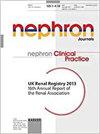Genetic Deletion of the Stromal Cell Marker CD248 (Endosialin) Protects against the Development of Renal Fibrosis
引用次数: 23
Abstract
Background: Tissue fibrosis and microvascular rarefaction are hallmarks of progressive renal disease. CD248 is a transmembrane glycoprotein expressed by key effector cells within the stroma of fibrotic kidneys including pericytes, myofibroblasts and stromal fibroblasts. In human disease, increased expression of CD248 by stromal cells predicts progression to end-stage renal failure. We therefore, hypothesized that the genetic deletion of the CD248 gene would protect against fibrosis following kidney injury. Methods: Using the unilateral ureteral obstruction (UUO) model of renal fibrosis, we investigated the effect of genetic deletion of CD248 on post obstructive kidney fibrosis. Results: CD248 null mice were protected from fibrosis and microvascular rarefaction following UUO. Although the precise mechanism is not known, this may to be due to a stabilizing effect of pericytes with less migration and differentiation of pericytes toward a myofibroblast phenotype in CD248-/- mice. CD248-/- fibroblasts also proliferated less and deposited less collagen in vitro. Conclusion: These studies suggest that CD248 stromal cells have a pathogenic role in renal fibrosis and that targeting CD248 is effective at inhibiting both microvascular rarefaction and renal fibrosis through modulation of pericyte and stromal cell function.间质细胞标志物CD248(内啡肽)的基因缺失可预防肾纤维化的发生
背景:组织纤维化和微血管稀疏是进展性肾脏疾病的标志。CD248是一种跨膜糖蛋白,由纤维化肾间质中的关键效应细胞表达,包括周细胞、肌成纤维细胞和间质成纤维细胞。在人类疾病中,间质细胞CD248表达的增加预示着终末期肾衰竭的进展。因此,我们假设CD248基因的基因缺失可以防止肾损伤后的纤维化。方法:采用单侧输尿管梗阻(UUO)肾纤维化模型,研究CD248基因缺失对梗阻后肾纤维化的影响。结果:CD248缺失小鼠在UUO后可免受纤维化和微血管稀疏的影响。虽然确切的机制尚不清楚,但这可能是由于在CD248-/-小鼠中,周细胞向肌成纤维细胞表型的迁移和分化较少,具有稳定作用。CD248-/-成纤维细胞在体外增殖和沉积的胶原也较少。结论:这些研究提示CD248间质细胞在肾纤维化中具有致病作用,靶向CD248可通过调节周细胞和间质细胞功能有效抑制微血管稀疏和肾纤维化。
本文章由计算机程序翻译,如有差异,请以英文原文为准。
求助全文
约1分钟内获得全文
求助全文

 求助内容:
求助内容: 应助结果提醒方式:
应助结果提醒方式:


